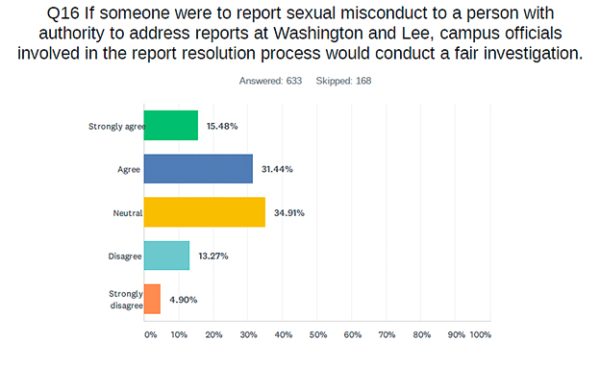New hazing training calls Greek initiation practices into question
Common initiation practices meet Virginia’s definition of hazing, new university training reveals
Pi Kappa Alpha’s house near Washington and Lee’s campus. All students, not just members of fraternities and sororities, must undergo hazing prevention training, in part to encourage bystander intervention.
October 27, 2022
Washington and Lee implemented a more thorough hazing prevention training program for all students this year in response to Adam’s Law, a new anti-hazing statute in Virginia.
The hour-long training was developed by Jan Kaufman, the university’s director of health promotion, and Assistant Dean of Students Kyle McCoil. A group of staff and student facilitators also help deliver the training.
Associate Dean of Students Megan Hobbs said the university has always provided anti-hazing training, but this programming is “more comprehensive.” The training covers warning signs, potential acts of hazing, the role that alcohol can play and how to report violations, among other topics.
Some practices commonly implemented by sororities and fraternities on campus meet the commonwealth’s definition of hazing, the training reveals. That includes practices that disproportionately target new members, such as requiring them to clean up after parties, under threat of punishment for a poor job, and sober driving programs that rely solely on new members.
McCoil said it’s up to the groups themselves to change their behavior.
“It’s more about asking them to be more intentional and have those conversations amongst themselves and just reflect on the practices,” McCoil said. “Our job as advisors is to advise and to remind them of their resources, of policies, of expectations.”
Still, students are able to formally report alleged violations of hazing, including the common practices identified as hazing in the training.
“If something is reported, it will be looked into,” McCoil said. “A violation is a violation.”
Mimi Sherrill, ’23, president of the National Panhellenic Council, which oversees six sororities on campus, said the training is designed to be “very interactive.” Sessions begin by introducing students to Virginia’s and Washington and Lee’s definitions of hazing, before identifying the three components of hazing.
In order for conduct to be deemed hazing, the act must occur in a group setting, without regard for consent, with the intention of embarrassment, intimidation, harassment or violence. Even if they agree to an action, victims of hazing can’t give consent, Sherrill said.
Students also go through case studies that ask them to identify whether a particular incident meets the definition of hazing.
Training has been underway since before the school year began. Student athletes received the training with their teams during pre-season, while first-years went through the training in one of the “Perspectives” sessions during orientation week. Greek organizations have received the training intermittently.
The rest of the student body will receive the training during four designated sessions on Oct. 24, Oct. 27, Nov. 10 and Nov. 15.
Virginia law defines hazing as such: “‘Hazing’ means to recklessly or intentionally endanger the health or safety of a student or students or to inflict bodily injury on a student or students in connection with or for the purpose of initiation, admission into or affiliation with or as a condition for continued membership in a club, organization, association, fraternity, sorority, or student body regardless of whether the student or students so endangered or injured participated voluntarily in the relevant activity.”
Adam’s Law, which mandates more robust hazing prevention education among universities, went into effect this year in response to the death of Adam Oakes, a former freshman at Virginia Commonwealth University. During a big-little reveal party in 2021, Oakes was ordered to chug 40 oz. of Jack Daniels.
After completing the task, Oakes passed out on the couch and, after hours of unresponsiveness, passed away.
Oakes’s blood alcohol content at time of death was .42. In comparison, the blood alcohol content of a patient under anesthesia is .35, Sherrill said.
“One phone call could have saved his life,” Sherrill said. “His death was 100% preventable, but they chose not to call someone for help.”
Based on the fact that some student organizations on campus, such as academic societies and clubs like Student Consulting, have initiation processes, the university decided to offer hazing training to all students, Hobbs said.
Making the training university-wide also encourages bystander prevention, McCoil said.
“Everyone has the ability to combat hazing behaviors, and first steps in doing that is for members of the community to understand the dangers and risk of hazing cultures, recognize what those behaviors look like, and then deciding to do something about it,” he said.
The new training program isn’t the only change to hazing policies the university has made this year. Adam’s Law requires that hazing violations be displayed publicly on the university website if the Department of Public Safety, which investigates the incidents, determines that a violation has occurred.
Names of offending organizations and descriptions of the violations will be updated at least once a semester and remain on the website for 10 years from the date of offense, Sherrill said.
The new reporting policies make it especially crucial that all students learn how to recognize instances of hazing, Sherrill said.
“People outside of these organizations don’t have these close ties to it,” she said. “If they see hazing, they’re not in the culture of silence. They’ll report it, hopefully.”
The university’s reporting process is anonymous, and Virginia law protects those that report a violation in “good faith” from disciplinary action related to alcohol and drug use and hazing, according to information published on the university’s website.
Retaliation is also prohibited against those who report or cooperate in investigations.
Sherrill said she hopes participants will walk away from the training ready to question longstanding practices.
“I’m hoping that people reevaluate the traditions that we keep up for no reason,” she said. “Tradition doesn’t justify hazing behaviors, and tradition does not justify intimidation, harassment and violence.”













